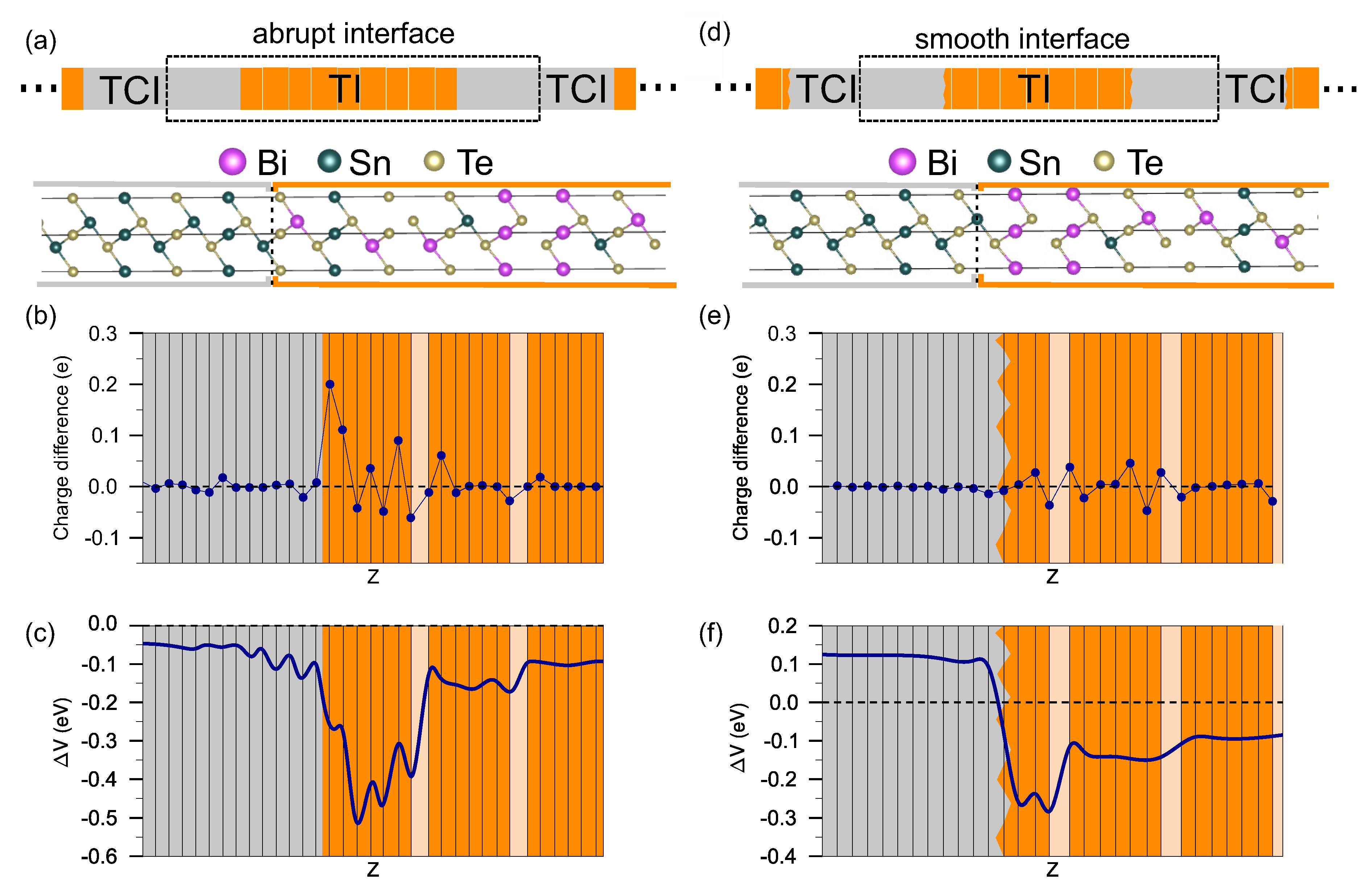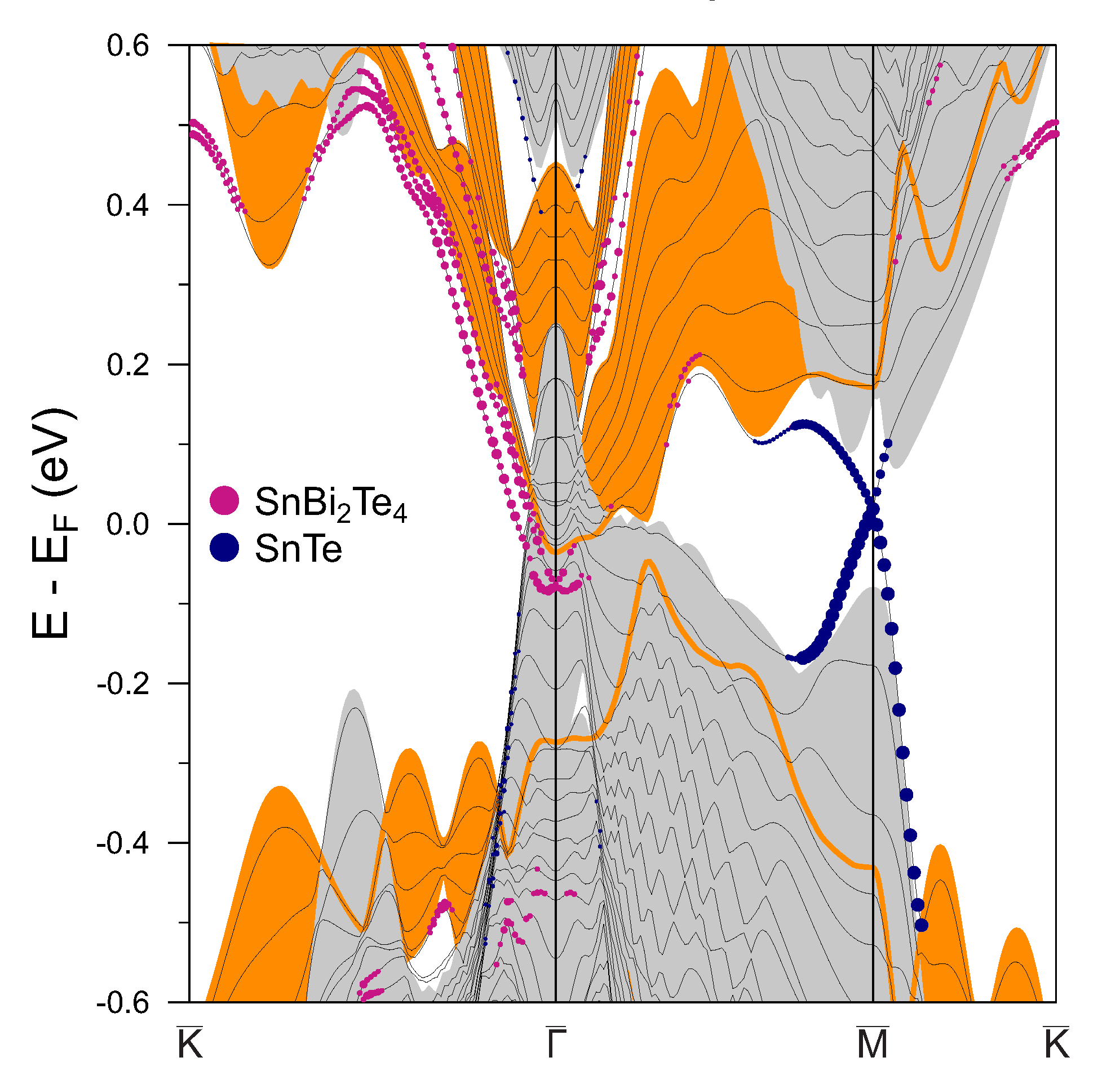Interplay of Topological States on TI/TCI Interfaces
Abstract
1. Introduction
2. Calculation Methods
3. Results and Discussion
4. Summary and Conclusions
Author Contributions
Funding
Acknowledgments
Conflicts of Interest
Abbreviations
| TI | Topological insulator |
| TCI | Topological crystalline insulator |
| QL | Quintuple-layer |
| SL | Septuple-layer |
| DFT | Density functional theory |
| VASP | Vienna Ab-initio Simulation Package |
| PBE | Perdew–Burke–Ernzerhof |
| ARPES | According to the angle-resolved photoemission spectroscopy |
| BZ | Brillouin zone |
References
- Zhang, H.; Liu, C.X.; Qi, X.L.; Dai, X.; Fang, Z.; Zhang, S.C. Topological insulators in Bi2Se3, Bi2Te3 and Sb2Te3 with a single Dirac cone on the surface. Nat. Phys. 2009, 5, 438. [Google Scholar] [CrossRef]
- Hasan, M.Z.; Kane, C.L. Colloquium: Topological insulators. Rev. Mod. Phys. 2010, 82, 3045–3067. [Google Scholar] [CrossRef]
- Moore, J.E. The birth of topological insulators. Nature 2010, 464, 194. [Google Scholar] [CrossRef] [PubMed]
- Hasan, M.Z.; Moore, J.E. Three-Dimensional Topological Insulators. Ann. Rev. Cond. Mat. Phys. 2011, 2, 55–78. [Google Scholar] [CrossRef]
- Bansil, A.; Lin, H.; Das, T. Colloquium: Topological band theory. Rev. Mod. Phys. 2016, 88, 021004. [Google Scholar] [CrossRef]
- Chen, Y.L.; Analytis, J.G.; Chu, J.H.; Liu, Z.K.; Mo, S.K.; Qi, X.L.; Zhang, H.J.; Lu, D.H.; Dai, X.; Fang, Z.; et al. Experimental Realization of a Three-Dimensional Topological Insulator, Bi2Te3. Science 2009, 325, 178–181. [Google Scholar] [CrossRef]
- Henk, J.; Ernst, A.; Eremeev, S.V.; Chulkov, E.V.; Maznichenko, I.V.; Mertig, I. Complex Spin Texture in the Pure and Mn-Doped Topological Insulator Bi2Te3. Phys. Rev. Lett. 2012, 108, 206801. [Google Scholar] [CrossRef]
- Otrokov, M.M.; Klimovskikh, I.I.; Bentmann, H.; Estyunin, D.; Zeugner, A.; Aliev, Z.S.; Gaß, S.; Wolter, A.U.B.; Koroleva, A.V.; Shikin, A.M.; et al. Prediction and observation of an antiferromagnetic topological insulator. Nature 2019, 576, 416–422. [Google Scholar] [CrossRef]
- Eremeev, S.V.; Landolt, G.; Menshchikova, T.V.; Slomski, B.; Koroteev, Y.M.; Aliev, Z.S.; Babanly, M.B.; Henk, J.; Ernst, A.; Patthey, L.; et al. Atom-specific spin mapping and buried topological states in a homologous series of topological insulators. Nat. Commun. 2012, 3, 635. [Google Scholar] [CrossRef]
- Fu, L. Topological Crystalline Insulators. Phys. Rev. Lett. 2011, 106, 106802. [Google Scholar] [CrossRef]
- Hsieh, T.H.; Lin, H.; Liu, J.; Duan, W.; Bansil, A.; Fu, L. Topological crystalline insulators in the SnTe material class. Nat. Commun. 2012, 3, 982. [Google Scholar] [CrossRef]
- Tanaka, Y.; Ren, Z.; Sato, T.; Nakayama, K.; Souma, S.; Takahashi, T.; Segawa, K.; Ando, Y. Experimental realization of a topological crystalline insulator in SnTe. Nat. Phys. 2012, 8, 800–803. [Google Scholar] [CrossRef]
- Liu, J.; Duan, W.; Fu, L. Two types of surface states in topological crystalline insulators. Phys. Rev. B 2013, 88, 241303. [Google Scholar] [CrossRef]
- Eremeev, S.V.; Koroteev, Y.M.; Nechaev, I.A.; Chulkov, E.V. Role of surface passivation in the formation of Dirac states at polar surfaces of topological crystalline insulators: The case of SnTe(111). Phys. Rev. B 2014, 89, 165424. [Google Scholar] [CrossRef]
- Dahal, B.R.; Dulal, R.P.; Pegg, I.L.; Philip, J. Topological crystalline insulator SnTe nanoribbons. Solid State Commun. 2017, 253, 42–45. [Google Scholar] [CrossRef]
- Wang, J.; Wang, N.; Huang, H.; Duan, W. Electronic properties of SnTe–class topological crystalline insulator materials. Chin. Phys. B 2016, 25, 117313. [Google Scholar] [CrossRef]
- Zou, K.; Albright, S.D.; Dagdeviren, O.E.; Morales-Acosta, M.D.; Simon, G.H.; Zhou, C.; Mandal, S.; Ismail-Beigi, S.; Schwarz, U.D.; Altman, E.I.; et al. Revealing surface-state transport in ultrathin topological crystalline insulator SnTe films. APL Mater. 2019, 7, 051106. [Google Scholar] [CrossRef]
- Zalic, A.; Dvir, T.; Steinberg, H. High-density carriers at a strongly coupled interface between graphene and a three-dimensional topological insulator. Phys. Rev. B 2017, 96, 075104. [Google Scholar] [CrossRef]
- Song, K.; Soriano, D.; Cummings, A.W.; Robles, R.; Ordejón, P.; Roche, S. Spin Proximity Effects in Graphene/Topological Insulator Heterostructures. Nano Lett. 2018, 18, 2033–2039. [Google Scholar] [CrossRef]
- Eremeev, S.V.; Men’shov, V.N.; Tugushev, V.V.; Echenique, P.M.; Chulkov, E.V. Magnetic proximity effect at the three-dimensional topological insulator/magnetic insulator interface. Phys. Rev. B 2013, 88, 144430. [Google Scholar] [CrossRef]
- Otrokov, M.M.; Menshchikova, T.V.; Rusinov, I.P.; Vergniory, M.G.; Kuznetsov, V.M.; Chulkov, E.V. Magnetic extension as an efficient method for realizing the quantum anomalous hall state in topological insulators. JETP Lett. 2017, 105, 297–302. [Google Scholar] [CrossRef]
- Hirahara, T.; Eremeev, S.V.; Shirasawa, T.; Okuyama, Y.; Kubo, T.; Nakanishi, R.; Akiyama, R.; Takayama, A.; Hajiri, T.; Ideta, S.I.; et al. Large-Gap Magnetic Topological Heterostructure Formed by Subsurface Incorporation of a Ferromagnetic Layer. Nano Lett. 2017, 17, 3493–3500. [Google Scholar] [CrossRef] [PubMed]
- Otrokov, M.M.; Menshchikova, T.V.; Vergniory, M.G.; Rusinov, I.P.; Vyazovskaya, A.Y.; Koroteev, Y.M.; Bihlmayer, G.; Ernst, A.; Echenique, P.M.; Arnau, A.; et al. Highly-ordered wide bandgap materials for quantized anomalous Hall and magnetoelectric effects. 2D Mater. 2017, 4, 025082. [Google Scholar] [CrossRef]
- Essin, A.M.; Moore, J.E.; Vanderbilt, D. Magnetoelectric Polarizability and Axion Electrodynamics in Crystalline Insulators. Phys. Rev. Lett. 2009, 102, 146805. [Google Scholar] [CrossRef]
- Qi, X.L.; Wu, Y.S.; Zhang, S.C. Topological quantization of the spin Hall effect in two-dimensional paramagnetic semiconductors. Phys. Rev. B 2006, 74, 085308. [Google Scholar] [CrossRef]
- Qi, X.L.; Hughes, T.L.; Zhang, S.C. Topological field theory of time-reversal invariant insulators. Phys. Rev. B 2008, 78, 195424. [Google Scholar] [CrossRef]
- Eremeev, S.V.; Tsirkin, S.S.; Nechaev, I.A.; Echenique, P.M.; Chulkov, E.V. New generation of two-dimensional spintronic systems realized by coupling of Rashba and Dirac fermions. Sci. Rep. 2015, 5, 12819. [Google Scholar] [CrossRef]
- Rauch, T.; Flieger, M.; Henk, J.; Mertig, I. Nontrivial interface states confined between two topological insulators. Phys. Rev. B 2013, 88, 245120. [Google Scholar] [CrossRef]
- Yang, S.; Wu, C.; Marom, N. Topological properties of SnSe/EuS and SnTe/CaTe interfaces. Phys. Rev. Mater. 2020, 4, 034203. [Google Scholar] [CrossRef]
- Takahashi, R.; Murakami, S. Gapless Interface States between Topological Insulators with Opposite Dirac Velocities. Phys. Rev. Lett. 2011, 107, 166805. [Google Scholar] [CrossRef]
- Rusinov, I.P.; Golub, P.; Sklyadneva, I.Y.; Isaeva, A.; Menshchikova, T.V.; Echenique, P.M.; Chulkov, E.V. Chemically driven surface effects in polar intermetallic topological insulators A3Bi. Phys. Chem. Chem. Phys. 2018, 20, 26372–26385. [Google Scholar] [CrossRef] [PubMed]
- Eremeev, S.V.; Otrokov, M.M.; Chulkov, E.V. Competing rhombohedral and monoclinic crystal structures in MnPn2Ch4 compounds: An ab-initio study. J. Alloys Compd. 2017, 709, 172–178. [Google Scholar] [CrossRef]
- Eremeev, S.V.; Otrokov, M.M.; Chulkov, E.V. New Universal Type of Interface in the Magnetic Insulator/Topological Insulator Heterostructures. Nano Lett. 2018, 18, 6521–6529. [Google Scholar] [CrossRef] [PubMed]
- Hirahara, T.; Otrokov, M.M.; Sasaki, T.; Sumida, K.; Tomohiro, Y.; Kusaka, S.; Okuyama, Y.; Ichinokura, S.; Kobayashi, M.; Takeda, Y.; et al. Fabrication of a novel magnetic topological heterostructure and temperature evolution of its massive Dirac cone. Nat. Commun. 2020, 11, 4821. [Google Scholar] [CrossRef] [PubMed]
- Blöchl, P.E. Projector augmented-wave method. Phys. Rev. B 1994, 50, 17953–17979. [Google Scholar] [CrossRef]
- Kresse, G.; Joubert, D. From ultrasoft pseudopotentials to the projector augmented-wave method. Phys. Rev. B 1999, 59, 1758–1775. [Google Scholar] [CrossRef]
- Kresse, G.; Furthmüller, J. Efficiency of ab-initio total energy calculations for metals and semiconductors using a plane-wave basis set. Comput. Mater. Sci. 1996, 6, 15–50. [Google Scholar] [CrossRef]
- Perdew, J.P.; Burke, K.; Ernzerhof, M. Generalized Gradient Approximation Made Simple. Phys. Rev. Lett. 1996, 77, 3865–3868. [Google Scholar] [CrossRef]
- Koelling, D.D.; Harmon, B.N. A technique for relativistic spin-polarised calculations. J. Phys. C Solid State Phys. 1977, 10, 3107–3114. [Google Scholar] [CrossRef]
- Grimme, S.; Antony, J.; Ehrlich, S.; Krieg, H. A consistent and accurate ab initio parametrization of density functional dispersion correction (DFT-D) for the 94 elements H-Pu. J. Chem. Phys. 2010, 132, 154104. [Google Scholar] [CrossRef]
- Grimme, S.; Ehrlich, S.; Goerigk, L. Effect of the damping function in dispersion corrected density functional theory. J. Comput. Chem. 2011, 32, 1456–1465. [Google Scholar] [CrossRef] [PubMed]
- Tung, Y.W.; Cohen, M.L. Relativistic Band Structure and Electronic Properties of SnTe, GeTe, and PbTe. Phys. Rev. 1969, 180, 823–826. [Google Scholar] [CrossRef]
- Tanaka, Y.; Shoman, T.; Nakayama, K.; Souma, S.; Sato, T.; Takahashi, T.; Novak, M.; Segawa, K.; Ando, Y. Two types of Dirac-cone surface states on the (111) surface of the topological crystalline insulator SnTe. Phys. Rev. B 2013, 88, 235126. [Google Scholar] [CrossRef]
- Medeiros, P.V.C.; Stafström, S.; Björk, J. Effects of extrinsic and intrinsic perturbations on the electronic structure of graphene: Retaining an effective primitive cell band structure by band unfolding. Phys. Rev. B 2014, 89, 041407. [Google Scholar] [CrossRef]
- Medeiros, P.V.C.; Tsirkin, S.S.; Stafström, S.; Björk, J. Unfolding spinor wave functions and expectation values of general operators: Introducing the unfolding-density operator. Phys. Rev. B 2015, 91, 041116. [Google Scholar] [CrossRef]
- Menshchikova, T.V.; Eremeev, S.V.; Koroteev, Y.M.; Kuznetsov, V.M.; Chulkov, E.V. Ternary compounds based on binary topological insulators as an efficient way for modifying the Dirac cone. JETP Lett. 2011, 93, 15. [Google Scholar] [CrossRef]
- Vergniory, M.G.; Menshchikova, T.V.; Silkin, I.V.; Koroteev, Y.M.; Eremeev, S.V.; Chulkov, E.V. Electronic and spin structure of a family of Sn-based ternary topological insulators. Phys. Rev. B 2015, 92, 045134. [Google Scholar] [CrossRef]
- Tang, W.; Sanville, E.; Henkelman, G. A grid-based Bader analysis algorithm without lattice bias. J. Phys. Condens. Matter 2009, 21, 084204. [Google Scholar] [CrossRef]
- Men’shov, V.N.; Tugushev, V.V.; Eremeev, S.V.; Echenique, P.M.; Chulkov, E.V. Band bending driven evolution of the bound electron states at the interface between a three-dimensional topological insulator and a three-dimensional normal insulator. Phys. Rev. B 2015, 91, 075307. [Google Scholar] [CrossRef]
- Eremeev, S.V.; Men’shov, V.N.; Tugushev, V.V.; Chulkov, E.V. Interface induced states at the boundary between a 3D topological insulator Bi2Se3 and a ferromagnetic insulator EuS. J. Magn. Magn. Mater. 2015, 383, 30–33. [Google Scholar] [CrossRef]




© 2020 by the authors. Licensee MDPI, Basel, Switzerland. This article is an open access article distributed under the terms and conditions of the Creative Commons Attribution (CC BY) license (http://creativecommons.org/licenses/by/4.0/).
Share and Cite
Menshchikova, T.V.; Eremeev, S.V.; Kuznetsov, V.M.; Chulkov, E.V. Interplay of Topological States on TI/TCI Interfaces. Materials 2020, 13, 4481. https://doi.org/10.3390/ma13204481
Menshchikova TV, Eremeev SV, Kuznetsov VM, Chulkov EV. Interplay of Topological States on TI/TCI Interfaces. Materials. 2020; 13(20):4481. https://doi.org/10.3390/ma13204481
Chicago/Turabian StyleMenshchikova, Tatiana V., Sergey V. Eremeev, Vladimir M. Kuznetsov, and Evgueni V. Chulkov. 2020. "Interplay of Topological States on TI/TCI Interfaces" Materials 13, no. 20: 4481. https://doi.org/10.3390/ma13204481
APA StyleMenshchikova, T. V., Eremeev, S. V., Kuznetsov, V. M., & Chulkov, E. V. (2020). Interplay of Topological States on TI/TCI Interfaces. Materials, 13(20), 4481. https://doi.org/10.3390/ma13204481



